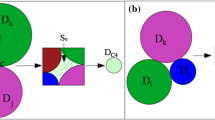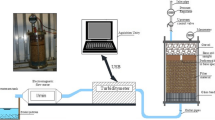Abstract
Granular filters in hydraulically loaded earth structures constitute the ultimate barrier for the blockage of small particles moving through the structure regularly or along concentrated leaks. If filters are inefficient to block small particles several types of internal erosion may be initiated. A corresponding phenomenon appears during suffusion in a wide graded hydraulically loaded fill, when fine particles, embedded in the pore structure of a soil skeleton, are washed out. The cumulative constriction size distribution (CSD) is physically the key property that qualifies the soils retention capability as like a spatial acting sieve. Constrictions are defined as the narrowest sections of channels between larger volumes (pores) within the pore network of granular material, and they are the main obstacles for a small particle to overcome when flowing along pathways. At least three different approaches are available to determine and compute the CSD, i.e., experimental, numerical and analytical methods. The purpose of this review is to present and discuss these methods pointing out their limits, advantages and significance related to internal erosion phenomena.
















Similar content being viewed by others
References
Al-Kharusi AS, Blunt MJ (2007) Network extraction from sandstone and carbonate pore space images. J Petrol Sci Eng 56(4):219–231
Al-Raoush R, Thompson K, Willson C (2003) Comparison of network generation techniques for unconsolidated porous media. Sci Soc Am J 67:1687–1700
Azma E, Radja F, Peyroux R, Richefeu V, Saussine G (2008) Short-time dynamics of a packing of polyhedral grains under horizontal vibrations. Eur Phys J E 26(3):327–335
Binner R, Homberg U, Prohaska S, Kalbe U, Witt KJ (2010) Identification of descriptive parameters of the soil pore structure using experiments and CT data. In: Proceedings of the 5th international conference on scour and erosion, pp 397–407
Bryant S, King P, Mellor D (1993) Network model evaluation of permeability and spatial correlation in a real random sphere packing. Transp Porous Media 11:53–70
Cnudde V, Boone M (2013) High-resolution X-ray computed tomography in geosciences: a review of the current technology and applications. Earth Sci Rev 123:1–17
De Mello VFB (1977) Reflections on design decisions of practical signifiance to embankment dams. Géotechnique 27(3):281–355
Delerue J, Perrier E, Zu Z, Velde B (1999) New algorithms in 3d image analysis and their application to the measurement of a spatialized pore size distribution. Phys Chem Earth 24:639–644
Garcia X, Akanji LT, Blunt M, Matthai S, Latham J (2009) Numerical study of the effects of particle shape and polydispersity on permeability. Phys Rev E (N021304):1–9
Homberg U, Baum D, Prohaska S, Kalbe U, Witt KJ (2012) Automatic extraction and analysis of realistic pore structures from ct data for pore space characterization of graded soil. In: Proceedings of 6th international conference on scour and erosion (ICSE-6); paper 181
Humes C (1996) Geofilters’96. In: A new approach to compute the void size distribution curves of protective filters. Bitech, Montreal, pp 57–66
Indraratna B, Raut A, Khabbaz H (2007) Constriction-based retention criterion for granular filter design. J Geotech Geoenviron Eng 133(3):266–276
Lindow N, Baum D, Hege HC (2011) Voronoi-based extraction and visualization of molecular paths. IEEE Trans Vis Comput Graph 17(12):2025–2034
Locke M, Indraratna B, Adikari G (2001) Time-dependent particle transport through granular filters. J Geotech Eng Div ASCE 127(6):521–528
Lucknikov V, Gavrilova M, Medvedev N, Voloshin V (2002) The voronoi-delaunay approach for the free volume analysis of a packing of balls in a cylindrical container. Future Gener Comput Syst 18:676–679
Moraci N, Mandaglio M, Ielo D (2012) A new theoretical method to evaluate the internal stability of granular soils. Can Geotech J 49:45–58
Musso A, Federico F (1983) Un metodo geometrico-probabilistico per la verifica dei filtri. Rivista Italiana di Geotecnica 4:173–193
Nolan G, Kavanagh P (1994) The size distribution of interstices in random packings of spheres. Powder Technol 78:231–238
Powell MJ (1980) Computer-simulated random packing of spheres. Powder Technol 25(1):45–52
Raut A, Indraratna B (2008) Further advancement in filtration criteria through constriction-based techniques. J Geotech Geoenviron Eng 134(6):883–887
Reboul N, Vincens E, Cambou B (2008) Statistical analysis of void size distribution in a simulated narrowly graded packing of spheres. Granul Matter 10(6):457–468
Reboul N, Vincens E, Cambou B (2010) A computational procedure to assess the distribution of constriction sizes for an assembly of spheres. Comput Geotech 37(1):195–206
Rémond S, Gallias J, Mizrahi A (2008) Characterization of voids in spherical particle systems by delaunay empty spheres. Granul Matter 10:329–334
Schuler U (1996) Geofilters’96. In: Scattering of the composition of soils—an aspect for the stability of granular filters. Bitech, Montreal, pp 21—34
Silin D, Patzek T (2006) Pore space morphology analysis using maximal inscribed spheres. Phys A 371:336–360
Silveira A (1965) An analysis of teh problem of washing through in protective filters. In: 6th international conference on soil mechanics and foundation engineering, Montreal, Canada, vol 2, pp 551–555
Silveira A, de Lorena Peixoto Jr J, Nogueira J (1975) On void size distribution of granular materials. In: 5th panamerican conference on soil mechanics and foundation engineering, Buenos Aires, Argentina, vol 3, pp 161–176
Sjah J, Vincens E (2013) Determination of the constriction size distribution of granular filters by filtration tests. Int J Numer Anal Methods Geomech 37(10):1231–1246
Soria M, Aramaki R, Viviani E (1993) Experimental determination of void size curves In: Filters in geotechnical and hydraulic engineering. Rotterdam: Balkema, pp 43–48
Studart AR, Gonzenbach UT, Tervoort E, Gauckler LJ (2006) Processing routes to macroporous ceramics: a review. J Am Ceram Soc 89(6):1771–1789
To H, Scheuermann A, Williams D (2012) A new simple model for the determination of the pore constriction size distribution. In: Proceedings of 6th international conference on scour and erosion (ICSE-6); paper 082
Wildenschild D, Hopmans J, Vaz C, Rivers M, Rikard D, Christensen B (2002) Using X-ray computed tomography in hydrology: systems, resolutions and limitations. J Hydrol 267:285–297
Witt K (1986) Filtrationsverhalten und bemessung von erdstoff-filtern. verffentl. Tech. Rep. 104, D. Inst. F. Bodenmechanik und Felsmechanik. Universitt Karlsruhe. Heft
Witt K (1993) Reliability study of granular filters. In: Brauns J, Heibaum M, Schuler U (eds) Filters in geotechnical and hydraulic engineering. Balkema, Rotterdam, pp 35–41
Wu L, Nzouapet BN, Vincens E, Bernat-Minana S (2012) Laboratory experiments and the determination of the constriction size distribution of granular filters. In: Proceedings of 6th international conference on scour and erosion (ICSE-6); paper 142
Acknowledgments
The first author wants to acknowledge the French Agency of Research (ANR) and the French Network for Civil Engineering and Urbanization (RGCU) for the financial support provided to the national research project ERINOH “internal erosion in hydraulic structures” from which many results presented herein were obtained. The second author wishes to acknowledge the German Research Foundation (DFG) for supporting the research project “Conditions of suffusive erosion phenomena in soils”. Special thanks to Mrs. D. Böttge, Fraunhofergesellschaft ITKS, Dresden, for the photographs of ceramic structures, Fig. 2.
Author information
Authors and Affiliations
Corresponding author
Rights and permissions
About this article
Cite this article
Vincens, E., Witt, K.J. & Homberg, U. Approaches to determine the constriction size distribution for understanding filtration phenomena in granular materials. Acta Geotech. 10, 291–303 (2015). https://doi.org/10.1007/s11440-014-0308-1
Received:
Accepted:
Published:
Issue Date:
DOI: https://doi.org/10.1007/s11440-014-0308-1




